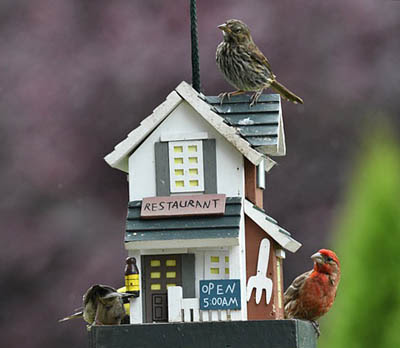Last Updated on January 21, 2024 by Greg Gillson
Are you planning on setting up a bird feeder this winter in South Carolina?
Are you looking for new ideas for winter bird feeding?
Are you wanting to know what birds come to feeders in winter in North Carolina?
Well, then, this article is for you!
This article tells why and how to set up a bird feeder in South Carolina in the winter. I’ll also show you photos of the common feeder birds in South Carolina that you can look for at your own backyard feeder! I will give brief identification tips. I will tell you what foods and what type of feeders attract each species.
Why feed winter birds in South Carolina?
Winter weather tends to be fairly mild in South Carolina. Inland winter temperatures often reach 40-45 degrees F. Nearer the coast, winter highs usually range from 55-60 degrees F. That’s nice!
Nevertheless, lows at night can get to freezing or below inland. And snow is possible, usually only 1-3 inches at most, in January.
But, in general, freezing spells are rare and short.
Many birds that breed in the north country migrate to South Carolina in winter. .
So your bird feeders here will have lots of birds!
While birds in South Carolina do not need our help to survive the winter, they will appreciate a steady supply of supplemental food that you may offer.
Bird feeding, especially in South Carolina, is more for the humans than the birds.
Watching birds bring joy. And having the birds visit you at your home brings that joy every day. Watching their antics and activities can relieve some of the anxiety of our modern lifestyle.
Birds are one of the easiest ways to connect with nature. And talking with your friends and neighbors about the birds at your feeder can help bring connection with other people. After all, bird feeding, and watching birds in general, is a popular pastime.
What birds come to feeders in winter in South Carolina?
The regular visitors to your feeders in winter are made up of year-round residents and also winter visitors from the north.
Learn the common dozen birds that visit in winter. Then you’ll recognize them all year long.
Soon you’ll notice if something more unusual shows up.
You don’t have to know the names of the birds to enjoy them. However, like your best friends, you will likely want to know their name! Once you know their names, you can research their behavior and seasonality, and really get to know them.
If you are interested, I have written an article on the most common backyard birds in South Carolina throughout the year. I link to it at the end of this article.
Here, then, are the winter birds in South Carolina that you are most likely to see at your bird feeder.
Tufted Titmouse
These plain birds are rather common at bird feeders in the East.
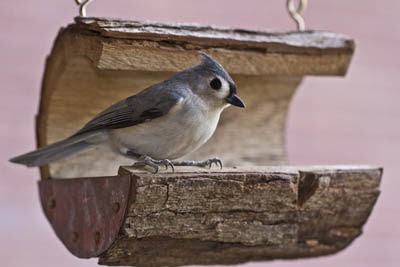 |
| Tufted Titmouse. Anne773 from Pixabay. |
These birds live year-round in deciduous woods east of the Great Plains in the United States.
Tufted Titmouses live year-round in South Carolina.
Small, a bit larger than chickadees. They are plain gray with a bit of black feathers on their forehead. The crest is often inconspicuous.
Tufted Titmouses eat black oil sunflower seeds from hopper feeders. They are also fond of peanuts.
Northern Cardinal
These are well-known birds due to their bright red coloration, fairly large size, and perky crest.
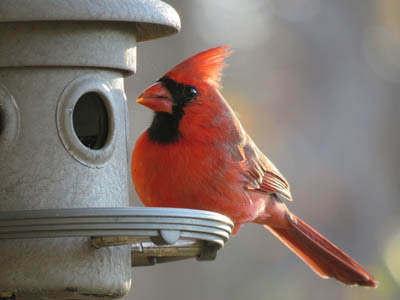 |
| Northern Cardinal. GeorgeB2 from Pixabay. |
These are year-round residents throughout the East and South.
Northern Cardinals are year-round residents throughout South Carolina.
Larger than sparrows, but smaller than robins. Males are bright red, females brown. They have thick orange bills, black chin and throat, and obvious crests.
Northern Cardinals eat larger seeds, including sunflower seeds and safflower seeds from hopper and platform feeders, but often feed on the ground.
Carolina Chickadee
This cute little bird is widespread throughout the southeastern United States in deciduous forests.
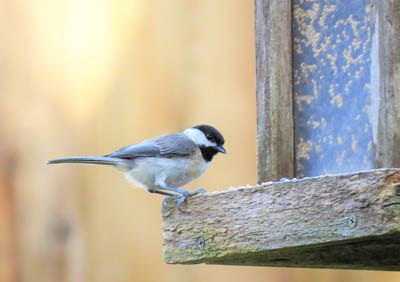 |
| Carolina Chickadee Image by George2 from Pixabay |
It is found in backyards and woodlands.
Carolina Chickadees are year-round residents throughout South Carolina.
It gives a rapid chick-a-dee-dee-dee call and a whistled song fee-bee, fee-bay.
Gray back, wings, tail, and pale gray flanks. Black cap and throat contrasting with white face.Carolina Chickadees like seeds, especially black oil sunflower seeds. They like suet, too. They eat from any kind of feeder.
Carolina Wren
This wren is a common resident in woodland tangles and backyards throughout the East.
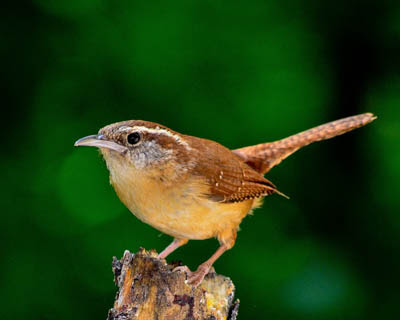 |
| Carolina Wren Image by SOARnet from Pixabay |
Carolina Wrens are year-round residents throughout South Carolina.
They sing all year, a loud musical teakettle, teakettle, teakettle or cheery cheery cheery. The call notes are loud and varied, including a chert call.
These have typical round wren bodies with short neck and long active tails. They are rich brown above, warm buffy below with a white throat and long white eyebrow strip back from the eye.
Carolina Wrens visit suet feeders.
Yellow-rumped Warbler
These are abundant little birds flitting through the trees in winter.
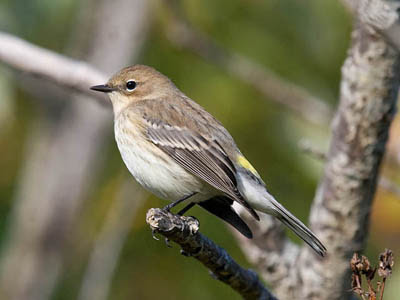 |
| Yellow-rumped Warbler Photo by Greg Gillson |
These abundant warblers nest in conifer and mixed forests across Alaska and Canada and in the mountains of the northeastern United States and the West. They winter along both Atlantic and Pacific coasts of the Unites States and across the southern states into Mexico.
They winter throughout South Carolina.
In summer they are very bright. The upper parts are bluish and they have a black chest. They have a yellow crown patch. Western birds have a yellow throat and large white wing patch. Eastern birds have white throat and two white wing bars.
In winter they are very dull. But, summer or winter, they flash white tail corners in flight and have a bright yellow rump.
They have a complicated slow warble ending in a trill. Their call note is a flat tchep.
While you may see Yellow-rumped Warblers crawling through leafy foliage gleaning insects, or flying out to snatch bugs out of the air, they will come to your feeder if you offer suet.
Red-bellied Woodpecker
These woodpeckers are fairly common at bird feeders in the East, especially where there are larger hardwood trees.
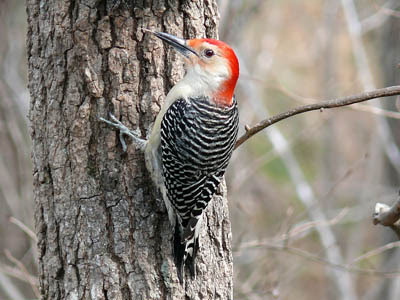 |
| Red-bellied Woodpecker. Skeeze from Pixabay. |
These birds live year-round in the United States east of the Rocky Mountains and Great Plains.
Red-bellied Woodpeckers live year-round throughout South Carolina.
These birds cling to tree trunks. They have finely barred black-and-white backs. The head and under parts are rather pale gray. Red feathers on the back of the neck reach the bill on males.
Red-bellied Woodpeckers love peanuts from platform feeders. They also eat sunflower seeds and suet.
White-throated Sparrow
These birds are fairly common in the East in winter, rather rare throughout the West.
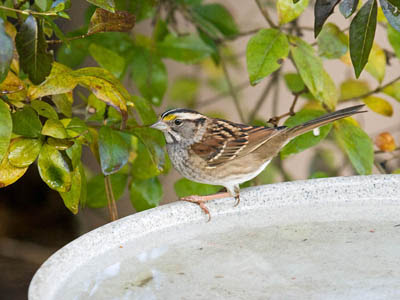 |
| White-throated Sparrow. Greg Gillson. |
These birds breed in Canada and northeastern United States. In winter they occur in the eastern and southern U.S.
White-throated Sparrows winter throughout South Carolina.
These fairly large brown and gray sparrows have a striped head. The head striping can be gray and tan or black and white. The obvious white throat is bordered on the sides with throat stripes and contrasts strongly with the gray breast.
White-throated Sparrows eat smaller seeds such as white proso millet found in better mixed seed brands. They prefer to eat on the ground or platform feeders, but will also use hopper feeders.
Downy Woodpecker
This small woodpecker is widespread in North America and fairly common at bird feeders in winter.
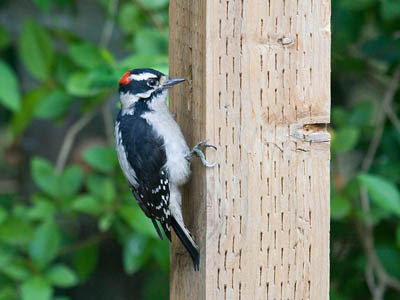 |
| Downy Woodpecker. Greg Gillson. |
Year-round residents from Alaska and across Canada south through the United States, but absent from the Desert Southwest.
Downy Woodpeckers are year-round residents throughout South Carolina.
These are less than 7 inches long, bill tip to tail tip. They have a black and white striped head, white back, and black wings with white spots.
Downy Woodpeckers love suet from suet feeders. They also eat hulled sunflower seeds.
American Goldfinch
These bright yellow-and-black birds are a favorite summer bird. However, many people don’t recognize these birds at their feeders in their dull brown winter plumage.
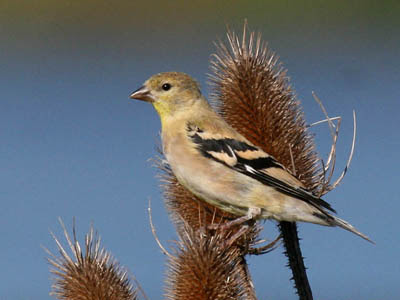 |
| American Goldfinch. Greg Gillson. |
Year-round residents across the northern half of the United States. In summer birds breed north well into Canada. In winter they move south throughout most of the U.S.
American Goldfinches are year-round residents in inland South Carolina; they are winter visitors only in lower coastal areas.
These are tiny birds with short forked black tails. Wings are black. Winter birds are dull brownish. In summer females are green while males are brilliant lemon yellow with black cap.
American Goldfinches eat black oil sunflower seeds from tube feeders. They love Niger seed from thistle feeders.
House Finch
These are one of the most widespread feeder birds in the United States.
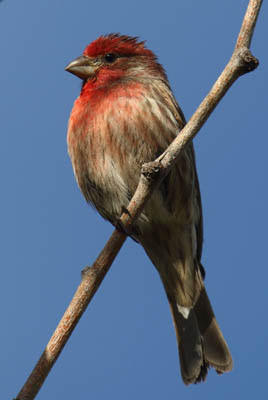 |
| House Finch. Greg Gillson. |
These birds are resident in towns throughout the United States, barely into southern Canada.
House Finches are year-round residents in South Carolina.
Both males and females are rather dusty brown, heavily streaked on the chest. Only the males have red feathers on forehead, breast, and rump.
House Finches love to eat black oil sunflower seeds in the shell. They like tube feeders best.
Song Sparrow
This is a common wetland bird across North America that also hides out in backyards with large bushes and hedges.
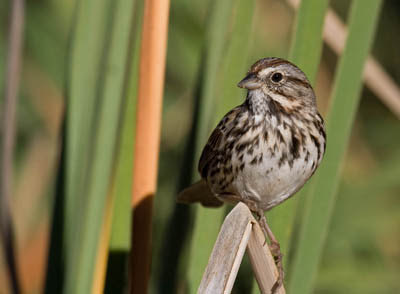 |
| Song Sparrow Photo by Greg Gillson |
Song Sparrows are year-round residents throughout South Carolina.
It forages and hops on the ground where its heavy dark brown streaking provides camouflage in the shadows.
It has a a trilled song that starts with two burry notes and a buzz. Its call sounds like chimp.
Song Sparrows will eat mixed seeds and black oil sunflower seeds from a hopper or platform feeder.
Mourning Dove
These birds are one of the most widespread in North America.
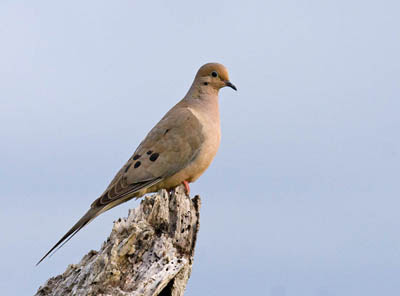 |
| Mourning Dove. Greg Gillson. |
In summer they breed in open fields, farms, prairies, towns, across all of the United States and north into Canada. In winter they depart most of Canada and the northern Great Plains and higher elevations in the northern states.
Mourning Doves are year-round residents throughout South Carolina.
These plump birds have a small round head and pointed tail. They are larger than most feeder birds, but not as large as a domestic pigeon.
Mourning Doves eat mixed seeds and grains. They prefer eating on the ground or from platform feeders.
Blue Jay
These are well-known birds, displayed in advertising and sports teams.
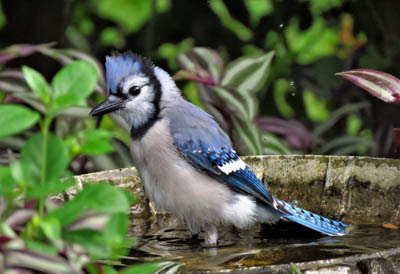 |
| Blue Jay. Skeeze from Pixabay. |
They live year-round in deciduous woods with oaks or nuts through most of the United States east of the Rocky Mountains. In summer they also migrate north well into Canada.
Blue Jays are year-round residents in South Carolina.
These are blue above, white below and on the face, with a black necklace across the throat wrapping behind the head. The blue crest is a distinguishing mark.
Blue Jays eat sunflower seeds. They love peanuts, too. They use hopper and platform feeders.
Setting up a winter bird feeding station in South Carolina
I would recommend a hopper feeder for feeding winter birds in South Carolina.
Hopper feeder will attract all of the seed eating birds on this list. Especially if you feed black oil sunflower seed, or a mixed seed that is at least 50% black oil sunflower.
Black oil sunflower seeds are a favorite of most seed eating birds, including: Tufted Titmouse, Carolina Chickadee, Northern Cardinal, American Goldfinch, and House Finch.
If you buy mixed bird seed, look for ingredients to include white proso millet as one of the first 2 or 3 ingredients, but avoid red milo. Birds that enjoy white proso millet include the White-throated Sparrow and Song Sparrow. Mourning Doves eat both the sunflower seeds and the millet.
Finally, I’d set up a suet feeder. Suet is a winter-time favorite of Carolina Chickadee and some of the other seed eaters. But they also attract other birds that might not come to your seed feeder. Birds that regularly feed on suet include Carolina Wren, Yellow-rumped Warbler, Red-bellied Woodpecker, Downy Woodpecker, and Blue Jay.
Wrapping Up
South Carolina is a fantastic destination for birdwatching in the winter! Here’s why:
Diverse Habitat:
- Coastline: Salt marshes, barrier islands, and open ocean attract a variety of coastal birds like ducks, geese, loons, terns, and shorebirds.
- Inland: Wetlands, forests, fields, and open spaces provide habitat for migrating songbirds, raptors, and finches.
- Warm Winter Climate: Compared to more northern states, South Carolina’s milder winter temperatures attract numerous migrant species seeking escape from harsh weather.
Abundant Food Sources:
- Coastal waters offer rich feeding grounds for fish-eating birds.
- Fields and woodlands provide seeds and berries for seed-eaters and frugivores.
- Feeders set up by backyard enthusiasts lure colorful finches and other species.
Accessibility and Resources:
- Numerous wildlife refuges, parks, and birding hotspots offer excellent birdwatching opportunities.
- Local birding groups and resources like eBird provide valuable information and tips for sightings.
- Coastal towns and communities often celebrate and support birdwatching activities.
Frequently Asked Questions
What birds migrate to South Carolina in the winter?
Many fascinating birds migrate to South Carolina in the winter, seeking warmer temperatures and abundant food sources. Here are some prominent winter migrants you might encounter:
Waterfowl:
- Ducks: American Wigeon, Ring-necked Duck, Green-winged Teal, Lesser Scaup, Ruddy Duck. These ducks flock to lakes, ponds, and coastal waters, often forming large rafts.
- Geese: Snow Geese, Canada Geese. Look for them in fields, marshes, and open water, where they graze on vegetation.
Other Waterbirds:
- Loons: Red-throated Loons, Horned Grebes. These diving birds frequent the ocean and coastal bays, often seen in winter plumage.
- Gulls and Terns: Royal Terns, Forster’s Terns, Bonaparte’s Gulls. Look for them soaring and diving along the coast, catching fish and crustaceans.
Landbirds:
- Songbirds: American Pipit, Savannah Sparrow, White-throated Sparrow, Fox Sparrow. These sparrows find food and shelter in fields, grasslands, and open woodlands.
- Finches: Pine Siskin, American Goldfinch. These colorful finches flock to feeders and trees, feeding on seeds and berries.
- Raptors: Red-tailed Hawk, Northern Harrier. These predators scan fields and open areas for prey, often soaring high in the sky.
Are there loons on Lake Murray South Carolina?
Yes, loons can be found on Lake Murray in South Carolina, but primarily during the winter months. They are not resident species in the area but migrate southward from their breeding grounds in Canada and the northern United States to escape the harsh winter conditions.
Specifically, two species of loons are most often seen on Lake Murray:
- Red-throated Loons: These are the most common loons encountered on the lake, arriving in October and staying until March. They prefer deeper areas of the lake and can be seen diving for fish.
- Common Loons: These loons are less frequent visitors, seen mainly from December to February. They also favor deeper parts of the lake and their haunting calls can be heard echoing across the water.
Related Articles:
The most common backyard birds in South Carolina
My recommended bird feeder setup
Bird seeds that attract the most birds
Different kinds of bird feeders for different birds
Bird baths that birds actually use







